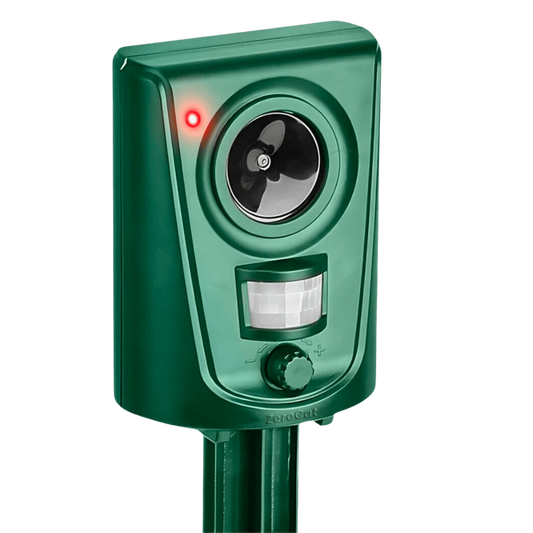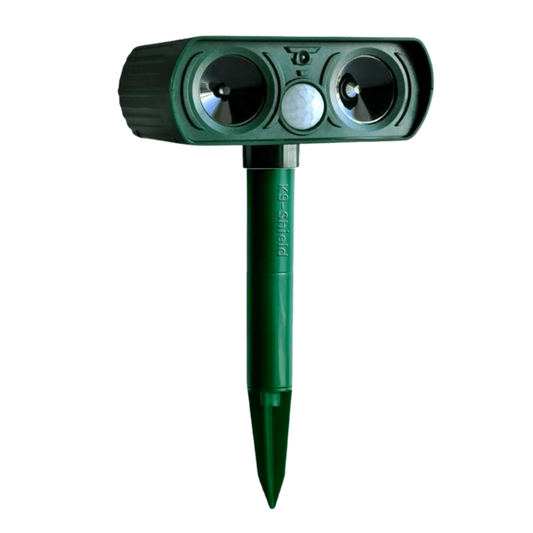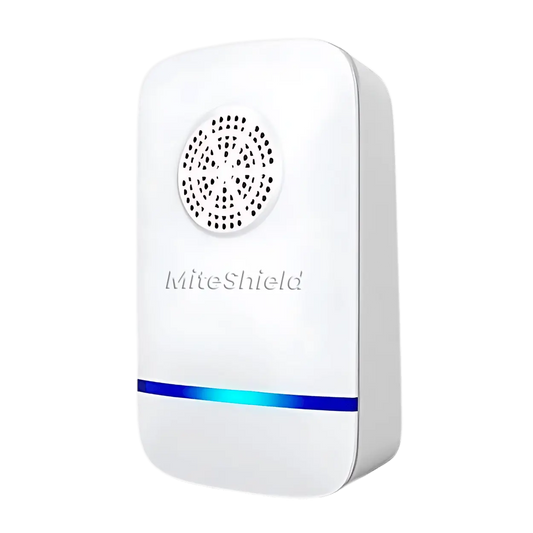Whether it's constant barking, digging, or unexpected visits, dealing with dog intrusions can quickly become frustrating. Among the many solutions available, ultrasonic dog deterrents promise a safe, hands-free way to keep dogs away but do they truly work? In this article, we’ll dive deep into real reviews, scientific insights, pros and cons, and practical advice to help you decide if ultrasonic repellents are the right choice for you.

What is an ultrasonic dog deterrent?
An ultrasonic dog deterrent is a device designed to emit high-frequency sound waves that are uncomfortable or irritating to dogs, but typically inaudible to humans. These devices operate in the ultrasonic range, usually above 20 kHz, a frequency range dogs can hear clearly, while our ears cannot.
The goal is simple: to discourage unwanted behavior or prevent dogs from entering specific areas without causing them harm. Whether it's a stray dog wandering into your yard, or a neighbor’s pet digging up your flowerbed, ultrasonic deterrents create a sound barrier that conditions dogs to stay away.
You’ll often find two types of ultrasonic dog deterrents:
- Handheld devices: ideal for joggers, mail carriers, or walkers who want a quick way to deter an approaching dog.
- Stationary outdoor units: designed to monitor an area and automatically emit sound when motion or barking is detected.
What makes these devices particularly appealing is their non-invasive and humane approach. There’s no need for physical barriers, chemicals, or confrontation. Instead, they rely on a dog's sensitive hearing to gently nudge them away from behaviors or areas you want to protect.
How do ultrasonic dog deterrents work?
Ultrasonic dog deterrents work by leveraging the sharp hearing capabilities of dogs. While humans can generally hear sounds up to 20 kHz, dogs can detect frequencies up to 45 kHz or even higher. These devices emit high-pitched sound waves that fall into this ultrasonic range, typically between 23 kHz and 30+ kHz, which are unpleasant for dogs but silent to us.
Here’s a breakdown of how they function:
- Sound emission: When triggered (either manually or automatically via motion/bark detection), the device emits a burst of ultrasonic sound.
- Discomfort without harm: The sound is not painful, but it’s annoying enough to grab the dog’s attention or make them retreat. It’s a bit like someone blowing a whistle right next to your ear.
-
Behavioral conditioning: Over time, dogs associate the sound with an unwanted action (like barking, trespassing, or digging). The goal is to discourage this behavior through repetition.
Depending on the model, the device may:
- Activate when it detects motion or barking (ideal for yards or driveways).
- Be manually triggered by pressing a button (useful on walks or in public areas).
- Include adjustable frequency settings to fine-tune effectiveness for different dog sensitivities.
The idea is to create a safe “warning zone” using sound rather than force. However, like any behavior-based solution, effectiveness can vary depending on the dog’s temperament, training, and how consistently the deterrent is used.
Effectiveness of ultrasonic dog deterrent: What science reveals

Scientific research on ultrasonic deterrents for dogs is limited but informative. Some animal behavior studies suggest that high-frequency sounds can interrupt and redirect behavior, particularly barking. In controlled environments, dogs showed signs of discomfort or attention shifts when exposed to ultrasonic signals. However, the long-term impact and consistency of these devices remain unclear.
A few key observations from available studies:
- Short bursts of sound may interrupt certain actions, like barking or approaching.
- Not all dogs respond the same: breeds with hearing sensitivities (like Border Collies or German Shepherds) may be more reactive than others.
- Habituation is possible: over time, dogs may become less responsive if the sound is not paired with training or consequences.
In short, ultrasonic deterrents are best viewed as a behavioral cue, not a standalone solution.
Pros and cons of using an ultrasonic dog deterrent
Ultrasonic dog deterrents promise a modern, humane solution to a common problem. But like any tool, they have their advantages and limitations. Understanding the pros and cons can help you decide whether this approach is right for your specific situation.
Pros of using an ultrasonic dog deterrent
- Safe and humane: No physical contact, no chemicals, and no harm to the dog
- Silent to humans: You won’t hear a thing, which makes it less disruptive in your environment compared to loud alarms or sprays.
- Hands-free control: Stationary models automatically activate via motion or bark detection, requiring little to no interaction.
- Portable options: Handheld models are ideal for personal safety during walks, jogging, or traveling.
- Low maintenance: Most devices are battery-powered or solar-charged and don’t require complex installation or frequent upkeep.
-
Versatile: Can deter not only dogs, but sometimes other animals like raccoons or deer, depending on the frequency range.
Cons of using an ultrasonic dog deterrent
- Not effective on all dogs: Some dogs simply don’t react or may get used to the sound over time, especially if it’s not paired with consistent reinforcement.
- Limited range: Most devices work within a specific radius (usually 15–30 feet). Barriers, corners, or weather can reduce effectiveness.
- Delayed results: It's not an instant fix. Repetition and context are often needed before a dog changes behavior.
- Environmental sensitivity: Wind, walls, and other obstructions can interfere with motion detection or sound delivery.
- May disturb other pets: If you have dogs or other animals at home, they may be affected even if they’re not the target.
-
Battery dependence: Some models require regular charging or battery replacement, which can be a hassle if you forget.
Best ultrasonic dog deterrent on the market

When it comes to protecting your yard from dogs, the K9 Shield by Sonic Barrier stands out as one of the most effective and best ultrasonic dog deterrents on the market. Built specifically to target dogs without harming them or disturbing other animals, this device offers a reliable, long-term solution for dog intrusions in outdoor areas.
The K9 Shield ultrasonic repellent provides a humane, safe, and powerful deterrent designed for dog-specific sensitivity ranges. It’s ideal for homeowners, joggers, or anyone looking to reclaim peace around their property without resorting to chemicals or aggressive methods. Whether you’re dealing with strays or a neighbor’s persistent pup, this is a smart, modern tool that gets the job done.
Product Overview
- Targeted Frequency Range: Calibrated specifically to match dogs’ hearing range (20–45 kHz), the K9 Shield ensures a targeted effect that dogs find unpleasant while remaining completely inaudible to humans.
- Coverage Area: Offers a wide 110° detection angle and covers up to 30 feet, making it perfect for driveways, yards, gardens, and patios.
- Dual Power Options: Equipped with both solar panels and a USB charging port, it delivers energy flexibility and up to 30 days of continuous operation on a full charge.
- Weatherproof Build: Rated IP65 waterproof, it’s built to resist rain, dust, and sun, ensuring reliable performance in all seasons.
- Smart Detection: Uses infrared motion detection to activate only when movement is detected, saving energy and enhancing effectiveness.
- Multi-Mode Protection: Features adjustable frequency settings to tailor the response to different dog temperaments or specific issues like barking or trespassing.
- Mounting Flexibility: Can be easily installed using the included ground stake for garden placement or mounting screws for fences and walls.
Performance Ratings
- Ease of Installation: 9/10
- Effectiveness: 8.5/10
- Build Quality: 8/10
- Value for Money: 8.5/10
Ultrasonic dog deterrent: What you should consider before buying
Before investing in an ultrasonic dog deterrent, it's important to evaluate a few key factors to ensure you choose the right model for your specific needs. Here’s what to look out for:
- Detection range and angle: Make sure the device covers the area you want to protect. A wider angle (100°+) and longer range (at least 20–30 ft) are ideal for yards or driveways.
- Power source: Choose between solar-powered, battery-operated, or USB rechargeable models depending on where and how often you plan to use it.
- Frequency adjustability: Some dogs may be more sensitive than others. Look for models with adjustable ultrasonic frequencies to fine-tune the deterrent effect.
- Weather resistance: For outdoor use, the device should be at least IPX4 or higher to withstand rain, dust, and changing temperatures.
- Mounting options: Ground stakes, wall mounts, or freestanding designs offer different levels of flexibility depending on your layout.
- Pet-friendly usage: If you have dogs or other animals at home, be sure the device won’t interfere with them unintentionally.
Tips for using ultrasonic dog deterrents effectively
To get the most out of your ultrasonic dog deterrent, proper setup and consistent use are key. While the technology is simple, how you use the device can greatly influence how well it works. Here’s how to ensure maximum effectiveness.
Best practices
- Position it strategically: Place the device where dogs usually enter or display unwanted behavior, near gates, along fences, or in areas where they bark or dig.
- Set the right angle and height: Most devices work best when installed 2–3 feet above ground, angled slightly downward toward the zone you want to protect.
- Start with a higher frequency: If the device allows adjustment, begin at a higher frequency to see if it effectively deters the dog, then fine-tune as needed.
- Combine with training or cues: If you’re using it on your own dog, pair the ultrasonic sound with a verbal “No” or redirection to reinforce the behavioral change.
- Give it time: Dogs may not react instantly. Use the deterrent consistently for a few days to allow the dog to associate the sound with the behavior.
- Check batteries or solar charge regularly: A dead or low-powered device won’t emit sound effectively. Make routine checks to ensure it’s powered and functional.
Mistakes to avoid
- Placing it too high or behind obstacles: Sound waves can be blocked by fences, bushes, or uneven terrain. Don’t mount the device where it can’t “see” the area clearly.
- Expecting instant results: It’s not a magic button. Dogs need repetition and consistency to change behavior. Don’t assume it’s broken if it doesn’t work day one.
- Using it as the only solution: Ultrasonic deterrents work best as part of a larger strategy. They may not stop aggressive or highly determined dogs alone.
- Leaving it on in high-traffic areas: Avoid placing the device where your own pets or neighbor’s dogs pass often unless you want them deterred too.
- Ignoring weather limitations: Not all devices are fully waterproof. Always check the weatherproof rating before placing it outdoors long-term.
- Using indoors without caution: If used indoors, make sure it won’t stress out your own pets. Indoor use is best suited for targeted behavior correction, not general deterrence.
Alternatives to ultrasonic dog deterrents
While ultrasonic devices offer a humane and hands-off way to deter dogs, they aren’t the only option. Depending on your environment, the dog's temperament, and whether you’re dealing with your own pet or strays, other solutions might work better, or enhance the effectiveness of your deterrent when used together.
Here are some of the most reliable alternatives:
- Scent-based repellents: Dogs have an incredibly sensitive nose, and there are certain smells that naturally repel dogs. Products made with citrus, vinegar, chili pepper, or citronella can be sprayed around problem areas to discourage digging, marking, or trespassing.
- Motion-activated sprinklers: These use infrared sensors to detect movement and release a short burst of water. Dogs (and other animals) quickly learn to avoid the area without any harm caused. It’s a simple, effective, and even a bit playful method for garden protection.
- Physical barriers: Installing fences, chicken wire, or spike mats can prevent access to certain zones. While more effort-intensive, they provide a long-term solution that doesn’t rely on behavior modification.
- Training and behavioral correction: For pet owners dealing with barking or destructive behavior, positive reinforcement training or professional help may be more effective than deterrents alone. Tools like clickers, reward systems, or leash training can go a long way.
- Dog deterrent sprays and granules: Widely available in pet stores, these ready-made formulas can be sprinkled or sprayed along borders, flowerbeds, or furniture to keep dogs away. They often use essential oils or bitter agents that are safe but unpleasant for dogs.
- Ultrasonic bark collars (for owned dogs): These devices are worn by the dog and emit a short ultrasonic sound in response to barking. They’re controversial and should only be used under guidance, but they can work when used responsibly.
- Traditional sound repellents (non-ultrasonic): Some devices emit high-pitched audible sounds or alarms to scare dogs away. These sounds to repel dogs can be effective in specific situations, but be careful—they may also disturb humans or other pets.

FAQ
Are ultrasonic dog deterrents safe?
Yes, ultrasonic dog deterrents are considered safe when used correctly. These devices emit high-frequency sound waves that are uncomfortable for dogs but do not cause pain or physical harm. The goal is to create a mild auditory irritation, similar to how a sudden loud noise might startle you, that deters unwanted behavior. Unlike shock collars or chemical sprays, ultrasonic deterrents are non-invasive, contact-free, and chemical-free, making them a more humane alternative. However, they should not be used excessively or near puppies with sensitive hearing, and should be avoided in confined indoor areas where pets cannot escape the sound.
When should you use an ultrasonic dog deterrent?
Ultrasonic dog deterrents are best used when you need a gentle but effective way to discourage dogs from specific behaviors or entering certain areas. Ideal situations include: stray dogs entering your yard, dogs barking excessively near your property, or your own pet engaging in behavior like digging or jumping on furniture. They're also great for joggers or delivery workers who want a hands-free way to deter aggressive dogs during outdoor activities. The key is to use the device proactively and consistently, right when the unwanted behavior occurs or is about to happen, so the dog can associate the sound with the action you're trying to stop.
Are ultrasonic deterrents legal to use in all U.S. states?
Yes, ultrasonic dog deterrents are generally legal to own and use in all U.S. states, as they are classified as non-lethal, non-contact behavior correction devices. Since they do not harm animals or humans and are often categorized under pet care or pest control products, no federal or state laws currently ban their use for personal property protection or training. However, local regulations on noise disturbance or nuisance may apply, especially in residential complexes or apartment settings. It’s a good idea to review community HOA rules or landlord policies if you plan to install one in a shared or high-traffic area.
How long does an ultrasonic dog deterrent take to work?
The effectiveness timeline for ultrasonic dog deterrents can vary depending on the situation and the dog’s sensitivity. Some dogs react immediately to the sound and change their behavior after just one or two exposures. Others may take several days or even weeks of consistent use to form the association. In general, results begin to appear within 3 to 7 days when the device is properly positioned and activated, only when the unwanted behavior occurs. Keep in mind that this is a behavioral conditioning tool, not a quick fix. Consistency, correct placement, and pairing with training cues can significantly speed up results.
Can dogs get used to ultrasonic sounds?
Yes, habituation is possible, especially if the ultrasonic deterrent is left on constantly or used too frequently without variation. Dogs are intelligent and adaptive creatures. If they realize the sound has no real consequence or threat, they may begin to ignore it. That’s why timing and consistency are crucial. The sound should only be triggered when the unwanted behavior happens, not as background noise. Some advanced deterrents offer variable frequencies or multi-mode operation to prevent dogs from adapting. If you notice reduced response over time, consider combining ultrasonic use with other deterrents or positive reinforcement training techniques.
Will an ultrasonic dog deterrent work on all breeds?
Ultrasonic deterrents are generally effective on most breeds, especially those with sensitive hearing and strong behavioral responsiveness, such as herding or working breeds (e.g., Border Collies, German Shepherds). However, results can vary depending on a dog's age, hearing ability, and temperament. Older dogs or those with hearing impairments may not react as strongly or at all to ultrasonic frequencies. Similarly, stubborn or highly focused breeds like Huskies or Terriers might ignore the discomfort if their drive is strong enough. While no breed is completely immune, it's wise to adjust expectations and supplement with other methods if needed.
Can ultrasonic dog deterrents affect other animals like cats or birds?
Yes, ultrasonic dog deterrents can potentially affect other animals, particularly those with sensitive hearing. Cats often hear in similar or even higher ranges than dogs, so they may react to the device, especially if they frequent the same space. Some devices are even marketed to repel both dogs and cats for this reason. Birds, however, are less likely to be affected unless they are very close to the device, as their hearing operates differently. If you have pets at home like rabbits, guinea pigs, or ferrets, you should monitor their behavior closely, as small animals are especially sound-sensitive. Always test the device in a controlled way before using it regularly around other pets.






